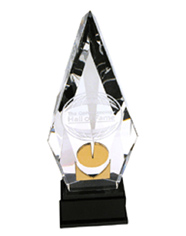
Two Determined Spirits
“A small body of determined spirits fired by an unquenchable faith in their mission can alter the course of history.” Mahatma Gandhi
The ASCRS Ophthalmology Hall of Fame was created by ASCRS to honor ophthalmology’s pioneers. In the past 11 years, 45 outstanding ophthalmologists have been chosen for induction by their peers. On April 21, 2012, the Hall inducts two more distinguished honorees: Louis Braille and Jack T. Holladay, MD.
Louis Braille was born in 1809 near Paris, France. At age three, he developed an infection that blinded both eyes by the time he was four. Despite his disability, Braille continued to attend school for two more years, but found learning only by listening to be difficult. He had to leave school when the curriculum required learning to read and write. At age 10 Braille got a scholarship to the Royal Institution for Blind Youth in Paris. As in his previous school, teachers relied on verbal instruction. The institute’s library had but 14 large books with (regular) raised letters, but Braille found them difficult to read.
In 1821, Charles Barbier, a former soldier, visited the Institute and shared his night writing code with Braille, who was then 12 years of age. The system used 12 raised dots arranged in cells or groups. Soldiers could “read” messages by passing a finger over them, thus avoiding the need for position-revealing light or speech.
Three years later, Braille had simplified Barbier’s 12-dot system into cells using 6 dots per cell to represent letters and numbers. Braille shared his system with officials at the Royal Institute, but was not taken seriously. Nevertheless, he persisted and secretly taught his method to students at the institute when he became an assistant teacher, and later when he was accepted for a full-time teaching position.
Over time Braille won limited support of the Institute’s leadership, and in 1829 the Institute published Braille’s book explaining his system. In 1834, he made the last major modifications to his braille system, which remains fundamentally the same today.
****
Dr. Jack T. Holladay was born in Kansas City, Kansas. He entered Southern Methodist University in 1964, and received his Bachelor of Science Degree in Electrical Engineering in 1969. His work in the Master’s program was primarily in Computer Science, where he developed software for the onboard aircraft computers to defeat Soviet radar systems. He also designed night vision optical devices using early IBM programs, which represented his first exposure to the field of optics.
In 1971, Dr. Holladay received his Master of Science Degree in Electrical Engineering from SMU and started course work toward a Doctorate. Attending classes at Southwestern Medical School was part of the Biomedical Engineering program, and this fostered an interest in the medical applications of his engineering background. As his interest grew, he decided to attend medical school.
Dr. Holladay was accepted in the first on-campus class of 32 members at The University of Texas Medical School in Houston. In 1974, he received his Doctorate of Medicine, followed by a year of research developing instrumentation for measuring the electrical charge of the eye. He completed his residency in ophthalmology in 1978 and was invited to join The University of Texas Medical School Faculty.
In addition to his teaching responsibilities and private practice, Dr. Holladay has invented the Brightness Acuity Tester, an instrument which is used by ophthalmologists all over the world for testing the effects of glare on patients’ vision. He has also developed the Holladay “IOL Consultant”, the Holladay 1, 2 & Refractive IOL formulas and “Refractive Surgery Consultant” software programs, which are currently used worldwide by ophthalmologists to help restore their patients’ vision following cataract removal and obtaining the best results following refractive surgery (LASIK).
Other career highlights, from a long list of many, include:
• Primary inventor of twelve patents
• Has written more than 100 scientific articles, 50 book chapters, authored or edited five books and made several hundred scientific presentations
• Invited as a Visiting Professor to many of the major ophthalmology programs internationally
• Received the Distinguished Service Award from the Commissioner of the U.S. Food and Drug Administration
• Received the Binkhorst Medal Award from the American Society of Cataract and Refractive Surgery
• Honored with the Ridley Medal from the European Society of Cataract and Refractive Surgery
• First recipient of the John Pearse Memorial Award from the United Kingdom & Ireland Society of Refractive Surgeons (UKISCRS)
• Received the Richard Lindstrom, MD Medal from the Contact Lens Association of Ophthalmologists…and the list continues.
M&S Technologies, Inc. has been privileged to work with Dr. Holladay in developing the Holladay Automated Contrast Sensitivity Testing System (HACSS), a patented CSF system with rotationally symmetric targets and randomly presented optotypes presented on our Smart System®. Please click here for more information on HACSS.
We congratulate Dr. Holladay on this honor and wish him continued success. Please stop by Booth 709 at ASCRS and see the HACSS protocol on the Smart System.
Text and image courtesy of ASCRS
Have a thought about this article? Contact Us and let us know.